 Web Front-end
Web Front-end JS Tutorial
JS Tutorial Understand the event propagation mechanism: capture and bubble order analysis
Understand the event propagation mechanism: capture and bubble order analysis
Events are captured first or bubbled first? Cracking the mystery of the event triggering sequence
Event processing is a very important part of web development, and the event triggering sequence is one of the mysteries. In HTML, events are usually propagated by "capturing" or "bubbling". Which should be captured first or bubbled first? This is a very confusing question.
Before answering this question, let’s first understand the “capture” and “bubble” mechanisms of events. Event capturing refers to delivering events layer by layer from the top element to the target node, while event bubbling refers to delivering events layer by layer from the target node to the top element. Both propagation methods play an important role in event processing.
In early browsers, the event propagation sequence was pioneered by Netscape. They believe that the propagation order of events should be from the outermost element to the inner element, and then from the inner element to the outer element. Therefore, the Netscape browser defines the event propagation sequence as event capture and event bubbling.
However, with the popularity of the Internet, Microsoft launched its own IE browser and adopted a different event propagation sequence from Netscape. They believe that the propagation of events should start from the innermost element to the outer element, and then propagate from the outer element to the inner element.
In order to solve this mutual incompatibility problem, W3C has developed a unified standard. According to W3C standards, the order of event propagation should be capturing first and then bubbling. This is the order of propagation currently followed by all modern browsers.
Specifically, when an event occurs on an element, the browser will first perform the event capture phase. In the event capture phase, the browser propagates events from the outermost element to the target element. When the event propagates to the target element, it enters the target phase. In the target phase, the browser executes the event handler bound to the target element. Finally, the event enters the bubbling stage, and the browser will propagate the event from the target element to the outer elements until it reaches the outermost element.
In order to better understand the event propagation sequence, we can demonstrate it through a simple example. Suppose we have an HTML document that contains three nested elements:
<div id="outer">
<div id="inner">
<button id="button">Click me</button>
</div>
</div>We bind an event handling function to each element, which is executed in the event capture phase and the bubbling phase respectively. We can achieve this through the following code:
var outer = document.getElementById('outer');
var inner = document.getElementById('inner');
var button = document.getElementById('button');
outer.addEventListener('click', function() {
console.log('Outer capture');
}, true);
inner.addEventListener('click', function() {
console.log('Inner capture');
}, true);
button.addEventListener('click', function() {
console.log('Button capture');
}, true);
outer.addEventListener('click', function() {
console.log('Outer bubble');
}, false);
inner.addEventListener('click', function() {
console.log('Inner bubble');
}, false);
button.addEventListener('click', function() {
console.log('Button bubble');
}, false);When we click the button, the result of the console output will be:
Outer capture Inner capture Button capture Button bubble Inner bubble Outer bubble
The order of event propagation can be clearly seen from the results. First, the browser will execute the event processing functions of the capture phase (Outer capture, Inner capture and Button capture) in order from outside to inside. Next, the browser will execute the event processing functions of the bubbling phase (Button bubble, Inner bubble and Outer bubble) in order from the inside to the outside.
Through this example, we can conclude that in modern browsers, the order of event propagation is to capture first and then bubble. This is mandated by standards set by the W3C.
In the actual development process, we usually use the event bubbling mechanism to handle events. Because the event bubbling mechanism can easily implement event delegation, reduce the number of event processing functions and improve performance. The event capture mechanism is relatively rarely used and is only used in some special circumstances.
In summary, the order of event propagation is to capture first and then bubble. By understanding the propagation mechanism of events, we can better handle events and improve the user experience of web pages.
The above is the detailed content of Understand the event propagation mechanism: capture and bubble order analysis. For more information, please follow other related articles on the PHP Chinese website!
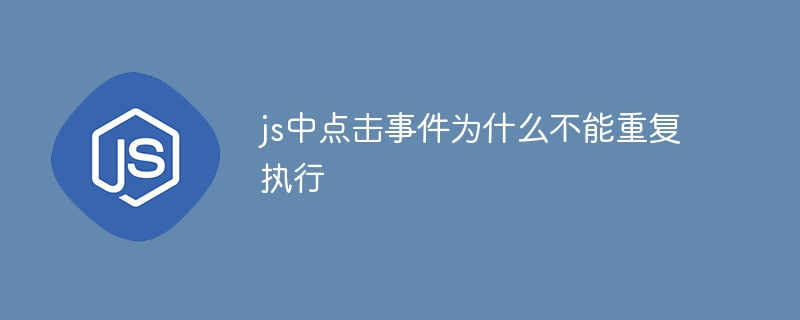 js中点击事件为什么不能重复执行May 07, 2024 pm 06:36 PM
js中点击事件为什么不能重复执行May 07, 2024 pm 06:36 PMJavaScript 中的点击事件不能重复执行,原因在于事件冒泡机制。为了解决此问题,可以采取以下措施:使用事件捕获:指定事件侦听器在事件冒泡之前触发。移交事件:使用 event.stopPropagation() 阻止事件冒泡。使用计时器:在一段时间后再次触发事件侦听器。
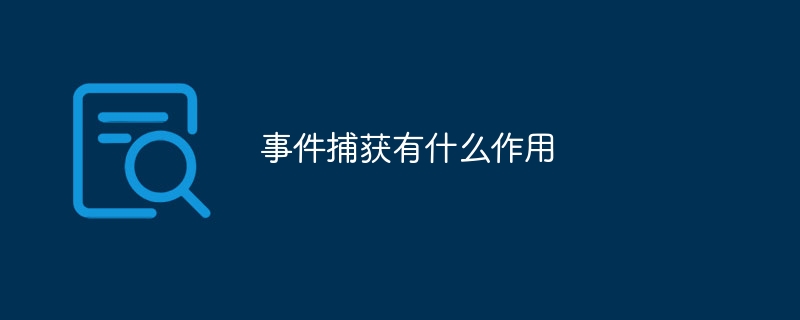 事件捕获有什么作用Nov 01, 2023 pm 01:16 PM
事件捕获有什么作用Nov 01, 2023 pm 01:16 PM事件捕获的作用包括方便获取目标元素和上下文信息、有效防止事件冒泡、自定义事件处理逻辑和提高页面响应速度等。详细介绍:1、方便获取目标元素和上下文信息,在事件捕获阶段,当一个事件发生时,浏览器会从最外层元素开始逐层向下查找与该事件相关联的元素,直到找到目标元素为止;2、有效防止事件冒泡,在事件模型中,一个事件发生时,会从最外层元素开始逐层向下传递,这个过程被称为事件冒泡等等。
 前端开发中的事件冒泡和事件捕获的实际应用案例Jan 13, 2024 pm 01:06 PM
前端开发中的事件冒泡和事件捕获的实际应用案例Jan 13, 2024 pm 01:06 PM事件冒泡与事件捕获在前端开发中的应用案例事件冒泡和事件捕获是前端开发中经常用到的两种事件传递机制。通过了解和应用这两种机制,我们能够更加灵活地处理页面中的交互行为,提高用户体验。本文将介绍事件冒泡和事件捕获的概念,并结合具体的代码示例,展示它们在前端开发中的应用案例。一、事件冒泡和事件捕获的概念事件冒泡(EventBubbling)事件冒泡是指在触发一个元
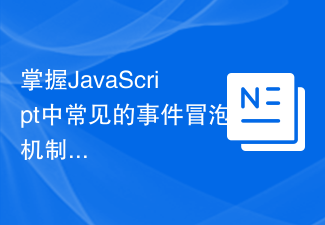 掌握JavaScript中常见的事件冒泡机制Feb 19, 2024 pm 04:43 PM
掌握JavaScript中常见的事件冒泡机制Feb 19, 2024 pm 04:43 PMJavaScript中常见的冒泡事件:掌握常用事件的冒泡特性,需要具体代码示例引言:在JavaScript中,事件冒泡是指事件会从嵌套层次最深的元素开始向外层元素传播,直到传播到最外层的父级元素。了解并掌握常见的冒泡事件,可以帮助我们更好地处理用户交互和事件处理。本文将介绍一些常见的冒泡事件,并提供具体的代码示例来帮助读者更好地理解。一、点击事件(click
 什么是事件冒泡事件捕获Nov 21, 2023 pm 02:10 PM
什么是事件冒泡事件捕获Nov 21, 2023 pm 02:10 PM事件冒泡和事件捕获是指在HTML DOM中处理事件时,事件传播的两种不同方式。详细介绍:1、事件冒泡是指当一个元素触发了某个事件,该事件将从最内层的元素开始传播到最外层的元素。也就是说,事件首先在触发元素上触发,然后逐级向上冒泡,直到达到根元素;2、事件捕获则是相反的过程,事件从根元素开始,逐级向下捕获,直到达到触发事件的元素。
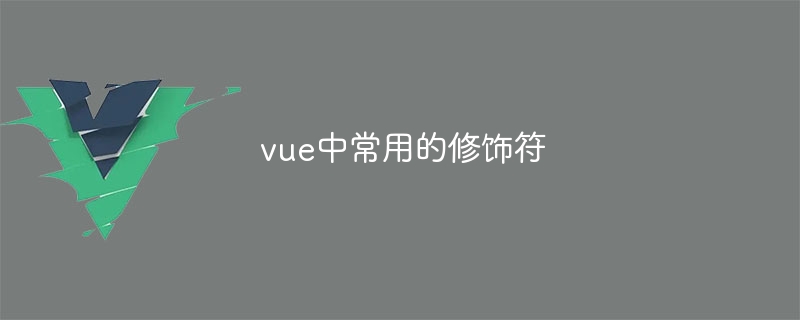 vue中常用的修饰符May 08, 2024 pm 04:27 PM
vue中常用的修饰符May 08, 2024 pm 04:27 PMVue.js 的修饰符用于修改指令行为,常用的修饰符包括:延迟执行(.lazy)、缓存计算结果(.memo)、强制转换为数字(.number)、修剪空格(.trim)、阻止默认行为(.prevent)、阻止事件冒泡(.stop)、仅执行一次(.once)、仅在当前元素触发(.self)、在事件捕获阶段触发(.capture)、在元素进入 DOM 时触发(.enter)、在元素离开 DOM 时触发(.leave)。
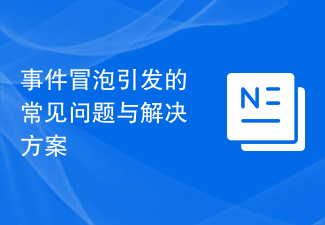 事件冒泡引发的常见问题与解决方案Feb 20, 2024 pm 06:48 PM
事件冒泡引发的常见问题与解决方案Feb 20, 2024 pm 06:48 PM事件冒泡(eventbubbling)是指在DOM中,当一个元素上的事件被触发时,它会向上冒泡到该元素的父级元素,再向上冒泡到更高级别的父级元素,直至冒泡到文档的根节点。虽然事件冒泡在许多情况下非常有用,但有时它也会引发一些常见的问题。本文将讨论一些常见的问题,并提供解决方案。第一个常见问题是多次触发事件。当一个元素上的事件冒泡到了多个父级元素时,可能会导
 哪些JS事件不会向上传播?Feb 19, 2024 am 08:17 AM
哪些JS事件不会向上传播?Feb 19, 2024 am 08:17 AMJS事件中哪些不会冒泡?在JavaScript中,事件冒泡是指当一个元素触发了某个事件时,该事件会逐级向上冒泡到更高层的元素,直到冒泡到文档根节点。然后,事件处理程序会按照冒泡的顺序依次执行。然而,并不是所有的事件都会冒泡。有些事件在触发后只会执行目标元素上的事件处理程序,而不会冒泡到更高层的元素上。下面是一些常见的不会冒泡的事件:focus和blur事件:


Hot AI Tools

Undresser.AI Undress
AI-powered app for creating realistic nude photos

AI Clothes Remover
Online AI tool for removing clothes from photos.

Undress AI Tool
Undress images for free

Clothoff.io
AI clothes remover

AI Hentai Generator
Generate AI Hentai for free.

Hot Article

Hot Tools

SAP NetWeaver Server Adapter for Eclipse
Integrate Eclipse with SAP NetWeaver application server.

Dreamweaver CS6
Visual web development tools

Safe Exam Browser
Safe Exam Browser is a secure browser environment for taking online exams securely. This software turns any computer into a secure workstation. It controls access to any utility and prevents students from using unauthorized resources.

WebStorm Mac version
Useful JavaScript development tools

SecLists
SecLists is the ultimate security tester's companion. It is a collection of various types of lists that are frequently used during security assessments, all in one place. SecLists helps make security testing more efficient and productive by conveniently providing all the lists a security tester might need. List types include usernames, passwords, URLs, fuzzing payloads, sensitive data patterns, web shells, and more. The tester can simply pull this repository onto a new test machine and he will have access to every type of list he needs.




